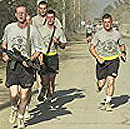 | | Soldiers jog every day to keep their body fit in their tour of duty but have to endure the dust around the base |
Even to a physician like U.S. Army Capt. D.J. Doyle, the list of diseases in Afghanistan is frightening: typhoid fever, dengue fever, polio, cholera, leishmaniasis, Crimean-Congo hemorrhagic fever. And then there's the dust. "I go running every day. The first time I saw the dust in the air, I thought 'Oh my God, I'm going to get so sick,'" said Doyle, 38, acting surgeon for the 82nd Airborne Division in Afghanistan. "But it just hasn't happened." The threat of disease and ailments hangs over any military force entering a foreign environment. In a country like Afghanistan, where sanitation and Western hygiene standards are virtually nonexistent and soldiers interact with the populace regularly, the prospect is even more unnerving. "For a U.S.-trained physician and soldier, the idea of going to a place where something like hemorrhagic fever is endemic scares the hell out of me," Doyle said. U.S. medical planners' fears of illness were based on past experience. In Vietnam, malaria sapped many troops' strength. Concerns were also stoked by the experience of the Soviet army during its war and occupation of Afghanistan in the 1980s. An estimated two-thirds of all Soviet troops who fought in Afghanistan were hospitalized with some disease or illness. Hepatitis A, typhoid fever, malaria, dysentery and even plague were the primary diseases that afflicted the Soviets. "It's not unrealistic to say the Soviets lost the war here because of disease non-battle injuries," Doyle said. For U.S. military troops, disease non-battle injury rates have run at about 1 percent since U.S operations began in Afghanistan last November. Most problems have been respiratory, which is attributed to the high altitudes and the dusty environment. Because many diseases in Afghanistan are also water- or food-borne, efforts also focus on basic hygiene. Combat troops out in the field are given bottles of anti-bacterial hand lotion and warned to stay away from locally-grown produce. But all these things are not enough. "The bottom line is that war is not a healthy thing." Doyle said. (Agencies) | 伤寒病、登革热、小儿麻痹症、霍乱、黑热病、克里米亚-刚果出血热…… 连美军上尉军医D.J都勒对阿富汗境内的种种疾病都感到心惊胆战。 除此以外,还有更大的隐患--尘土。 38岁的都勒是美军驻阿第82空降师的代理外科医生。他说:"我每天都要跑步锻炼身体。当我第一次看到空气中的大量尘土时就想,上帝啊,我会得病的。还好现在我还没有病倒。" 对于任何一个进入别国境内作战的军队来说,疾病随时都有可能降临。而像在阿富汗这样一个国家,卫生设施或西方卫生标准根本不存在,士兵还要跟当地平民频繁接触,沾染传染疾病的可能性就更大了。  | | 阿富汗战场上的美国大兵在吃空投的快餐 |
都勒说:"尽管身为一名训练有素的美国军医,只要想到我们要去的地方蔓延着出血热等疾病,我还是害怕得够呛。"
美国医疗规划者们对疾病的担心是有据可循的。在越战期间,疟疾拖垮了许多士兵。而在二十世纪八十年代苏联对阿富汗的战争中,阿富汗当地的传染病也是造成苏军受挫的一个重大原因。 据统计,在阿富汗作战的苏军士兵有三分之二染上了疾病。甲肝、伤寒、疟疾、痢疾甚至瘟疫是折磨苏军的主要疾病。 都勒说:"不夸张地说,是没有硝烟的病痛让苏军打了败仗。" 自从去年11月美军在阿富汗地区展开军事行动至今,美军士兵的染病率在1%左右。其中大部分是由于当地的高海拔和尘土环境导致的呼吸系统疾病。 在阿富汗,有许多疾病是通过水或食物传播的,因此美军的主要措施就是改善基础卫生条件。部队为在外作战的士兵提供瓶装抗菌水、洗手液,并警告他们离当地食品远一点。 但所有的这些措施都是不够的。都勒无奈地说:"归根结蒂,战争本来就不是健康的。" scares the hell out of me: 把我吓了一大跳
bottom line: 底线 (中国日报网站译) |
